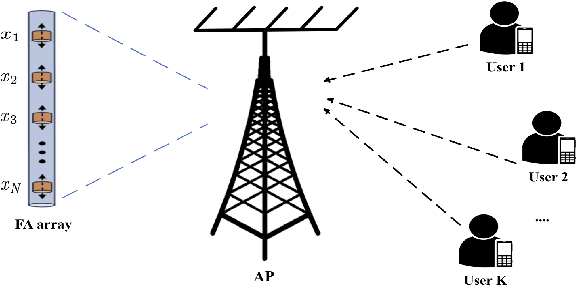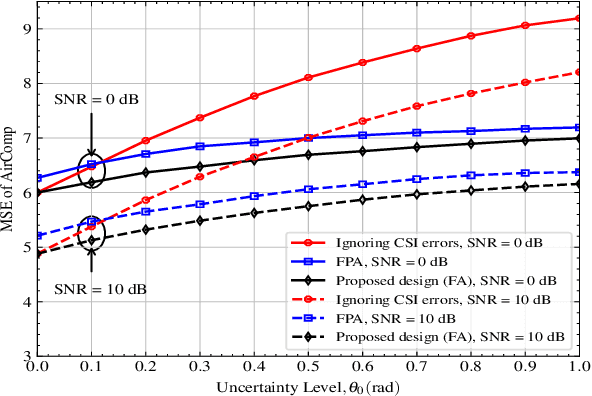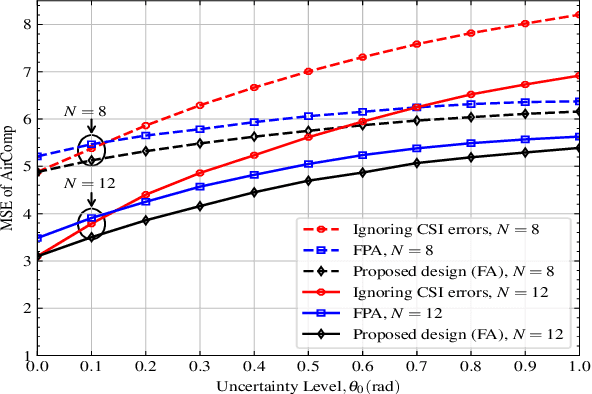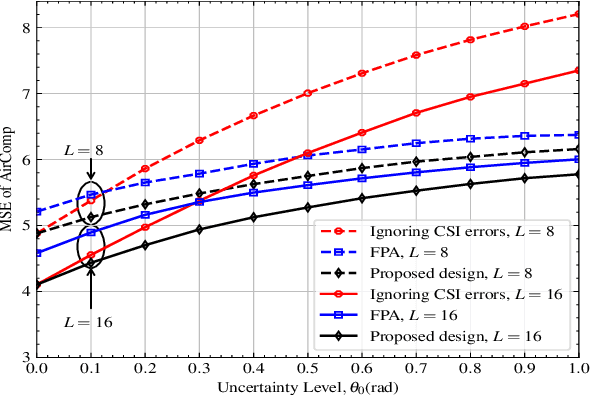Saeid Pakravan
Robust Resource Allocation for Over-the-Air Computation Networks with Fluid Antenna Array
Apr 22, 2025



Abstract:Fluid antenna (FA) array is envisioned as a promising technology for next-generation communication systems, owing to its ability to dynamically control the antenna locations. In this paper, we apply FA array to boost the performance of over-the-air computation networks. Given that channel uncertainty will impact negatively not only the beamforming design but also the antenna location optimization, robust resource allocation is performed to minimize the mean squared error of transmitted messages. Block coordinate descent is adopted to decompose the formulated non-convex problem into three subproblems, which are iteratively solved until convergence. Numerical results show the benefits of FA array and the necessity of robust resource allocation under channel uncertainty.
Enhancement of Over-the-Air Federated Learning by Using AI-based Fluid Antenna System
Jul 03, 2024
Abstract:This letter investigates an over-the-air federated learning (OTA-FL) system that employs fluid antennas (FAs) at the access point (AP) to enhance learning performance by leveraging the additional degrees of freedom provided by antenna mobility. First, we analyze the convergence of the OTA-FL system and derive the optimality gap to illustrate the influence of FAs on learning performance. Then, we formulate a nonconvex optimization problem to minimize the optimality gap by jointly optimizing the positions of the FAs and the beamforming vector. To address the dynamic environment, we cast this optimization problem as a Markov decision process (MDP) and propose the recurrent deep deterministic policy gradient (RDPG) algorithm. Finally, extensive simulations show that the FA-assisted OTA-FL system outperforms systems with fixed-position antennas and that the RDPG algorithm surpasses the existing methods.
Physical Layer Security for NOMA Systems: Requirements, Issues, and Recommendations
Aug 10, 2023Abstract:Non-orthogonal multiple access (NOMA) has been viewed as a potential candidate for the upcoming generation of wireless communication systems. Comparing to traditional orthogonal multiple access (OMA), multiplexing users in the same time-frequency resource block can increase the number of served users and improve the efficiency of the systems in terms of spectral efficiency. Nevertheless, from a security view-point, when multiple users are utilizing the same time-frequency resource, there may be concerns regarding keeping information confidential. In this context, physical layer security (PLS) has been introduced as a supplement of protection to conventional encryption techniques by making use of the random nature of wireless transmission media for ensuring communication secrecy. The recent years have seen significant interests in PLS being applied to NOMA networks. Numerous scenarios have been investigated to assess the security of NOMA systems, including when active and passive eavesdroppers are present, as well as when these systems are combined with relay and reconfigurable intelligent surfaces (RIS). Additionally, the security of the ambient backscatter (AmB)-NOMA systems are other issues that have lately drawn a lot of attention. In this paper, a thorough analysis of the PLS-assisted NOMA systems research state-of-the-art is presented. In this regard, we begin by outlining the foundations of NOMA and PLS, respectively. Following that, we discuss the PLS performances for NOMA systems in four categories depending on the type of the eavesdropper, the existence of relay, RIS, and AmB systems in different conditions. Finally, a thorough explanation of the most recent PLS-assisted NOMA systems is given.
* 17 pages, 4 figures
 Add to Chrome
Add to Chrome Add to Firefox
Add to Firefox Add to Edge
Add to Edge